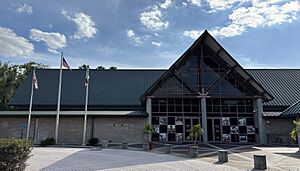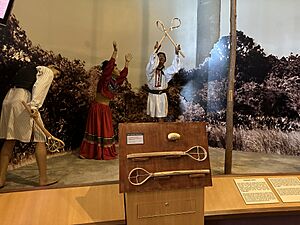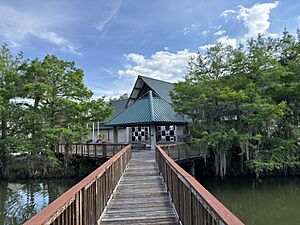Ah-Tah-Thi-Ki Seminole Indian Museum facts for kids

Ah-Tah-Thi-Ki Museum
|
|
| Established | 1997 |
|---|---|
| Location | 34725 West Boundary Road Big Cypress Reservation in Hendry County, Florida |
| Accreditation | American Association of Museums |
| Owner | Seminole Tribe of Florida |
The Ah-Tah-Thi-Ki Museum is a special place where you can learn about the Seminole people. It's located in Florida, on the Big Cypress Reservation. The Seminole Tribe of Florida owns and runs this museum. Its name, Ah-Tah-Thi-Ki, comes from a Seminole language phrase. It means "a place to learn, a place to remember."
The museum first opened its doors in 1997. It is connected with the Smithsonian Institution. In 2009, it became the first museum owned by a Native American tribe to be recognized by the American Association of Museums.
Contents
Learning About Seminole History
The Ah-Tah-Thi-Ki Museum helps keep Seminole history and culture alive. It does this by collecting stories, old documents, and special items.
Oral History Program
The museum has an Oral History Program. This program records the spoken words of Seminole people. It helps save their memories and culture. These recordings include interviews in the Miccosukee and Mvskoke languages. These interviews can be translated into English. This happens only when Seminole Tribal citizens approve it. The collection has many types of recordings.
Seminole Library and Archives
The museum also has a library and archives. These help preserve and share Seminole and Native American history. Researchers and the public can use these items.
- Government Documents: These papers are from the early 1800s to the mid-1900s. They cover 60 Native American tribes. They show how the United States government worked with different tribes.
- Newspaper Collection: This collection has news about the Seminole wars. It also shows how Native Americans and white settlers interacted.
- Special Collections: The museum has unique collections. These include photographs, travel diaries, and letters. Some letters describe experiences during the Seminole wars. There are also items that show Seminole Tribe activities.
The library has many shelves filled with materials. You can use these items inside the library. However, they cannot be taken out.
Caring for Artifacts
The Seminole museum has a special program to care for its artifacts. This program checks, records, and treats items from Seminole heritage. This careful work makes sure that these important artifacts last a long time. They remain useful resources at the museum.
Museum Collections
The museum has many interesting items. It has almost 200,000 pieces in its collection. They often change what is on display.
Permanent Collection

The items include patchwork clothing, dolls, and baskets. You can also see beadwork, sculptures, and paintings. Each part of the museum has a theme. These themes include daily life, rituals, and artwork.
The museum has interactive parts. These help visitors understand the topics better. There is also a 15-minute video. It tells the history of the tribe and the museum. This video helps you understand what you will see. It also explains why the museum is located where it is.
Online Collection
The museum has an online collection. You can look at many documents from home. These include archives and images about the Seminole Tribe. You can search this database by category. You can also use keywords or advanced search options.
Education and Events
The museum offers many ways to learn. It has programs for both Seminole Tribal members and others.
Education Programs
The museum's Education Division helps people learn. They teach about Seminole stories, history, and culture. This division offers tours and programs for students. They also have online learning materials. Teachers and students can use these in their classrooms.
American Indian Arts Celebration
The Ah-Tah-Thi-Ki Museum hosts a special event. It's called the American Indian Arts Celebration (AIAC). Visitors can enjoy traditional and modern arts and crafts. There is also dance, music, food, and wildlife shows. Native vendors sell their goods. The AIAC is fun for all ages. It's also a great place for school field trips.
Exploring the Boardwalk
Beyond the main museum building, there is a long boardwalk. It stretches for a mile through a 60-acre cypress area. There is also a Seminole Village. This village shows what older Seminole tourist camps were like.
Signs along the boardwalk tell you about plants and animals. They tell you their names in the Maskókî and Mikisúkî languages. They also explain how the Seminole Tribe used them. These signs connect tribal traditions with nature.
Museum History
The Ah-Tah-Thi-Ki Museum building was finished in 1989. But it opened to visitors on August 21, 1997. This opening day was special. It marked 40 years since the Seminole Tribe of Florida was officially recognized.
The museum has changed over time. It has had different directors. In 2005, a small museum location opened in Hollywood, Florida. This location closed in 2009.
Billy L. Cypress was one of the first directors. He was a Seminole Tribe member. He was also a US Army veteran and a college graduate. Tina M. Osceola became director after him. The current director is Gordon 'Ollie' Wareham. He is Billy L. Cypress's nephew. Their hard work has helped the museum grow.
The Seminole Tribe of Florida
The Seminole Tribe of Florida manages the museum. The Seminole people lived in Florida by the 1700s. After many conflicts, some were forced to move away. These groups became the Seminole Nation of Oklahoma and the Miccosukee Tribe of Indians of Florida.
A small group of about 300-700 Seminole people stayed in Florida. They kept their traditions alive. They relied on their family clans. In 1957, the Seminole Tribe of Florida was officially recognized.
When the Spanish arrived in Florida, they met the Miccosukee people. These were ancestors of the Seminole Tribe. The Seminole tribe traded with others and kept their traditions. But the United States began to take their land. This led to conflicts.
President Andrew Jackson signed a law. It forced Native Americans east of the Mississippi River to move west. Many Native people fought for their homes. Some followed a leader named Abiaki. He was also known as Sam Jones. Abiaki was a medicine man. He was a great leader and strategist. He did not want his people to leave their land.
After many wars, Abiaki led about 200 Seminole people into Florida's wetlands. This group survived. Today, they are a strong community. They have more than 5,000 tribal members. Their history led to the Ah-Tah-Thi-Ki Seminole Museum. The museum continues to keep Seminole traditions and history alive.


